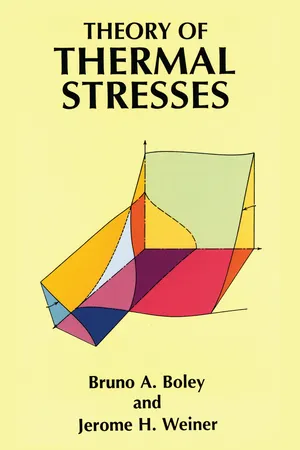
- 608 pages
- English
- ePUB (mobile friendly)
- Available on iOS & Android
Theory of Thermal Stresses
About this book
Elevated temperatures and extreme temperature gradients arise in a large variety of engineering problems, and often produced thermal stresses and thermal deformations that crucially affect the life of the materials and the systems involved. Early examples arose with the advent of high-speed rocket-powered flight and the development of nuclear energy sources. More recent applications can be found in fields ranging from reentry heating and ablation in space flight to the localized heat generation in computer chips, produced by high temperature during fabrication and by high current density during service.
This highly regarded text, aimed both at the researcher and the practicing engineer, as well as the student, presents a detailed discussion of fundamental aspects of the theory, accompanied by detailed solutions of typical and illustrative problems. The book is divided into four parts: Part I develops the fundamentals of thermoelasticity, starting with a presentation of the thermodynamic foundations of the subject and leading to various alternate formulations and methods of solutions of thermoelastic problems. Part II discusses the physical basis of heat transfer theory and methods of solution of heat conduction boundary-value problems. Part III covers more practical aspects of thermal stress analysis, mainly from the strength-of-materials viewpoint. Finally, Part IV presents the manner in which temperature effects can be included in inelasticity theory.
The result is an extremely useful resource which presents the salient features of the subject in a single volume from a unified and basic theoretical point of view.
Frequently asked questions
- Essential is ideal for learners and professionals who enjoy exploring a wide range of subjects. Access the Essential Library with 800,000+ trusted titles and best-sellers across business, personal growth, and the humanities. Includes unlimited reading time and Standard Read Aloud voice.
- Complete: Perfect for advanced learners and researchers needing full, unrestricted access. Unlock 1.4M+ books across hundreds of subjects, including academic and specialized titles. The Complete Plan also includes advanced features like Premium Read Aloud and Research Assistant.
Please note we cannot support devices running on iOS 13 and Android 7 or earlier. Learn more about using the app.
Information
CHAPTER | 1 |
Table of contents
- Cover
- Title Page
- Copyright Page
- Preface
- Contents
- Note on Bibliographical References
- part 1 Basic Theory
- part 2 Heat Conduction
- part 3 Thermal Stress Analysis for Elastic Systems
- part 4 Thermal Stress Analysis for Inelastic Systems
- Author Index
- Subject Index